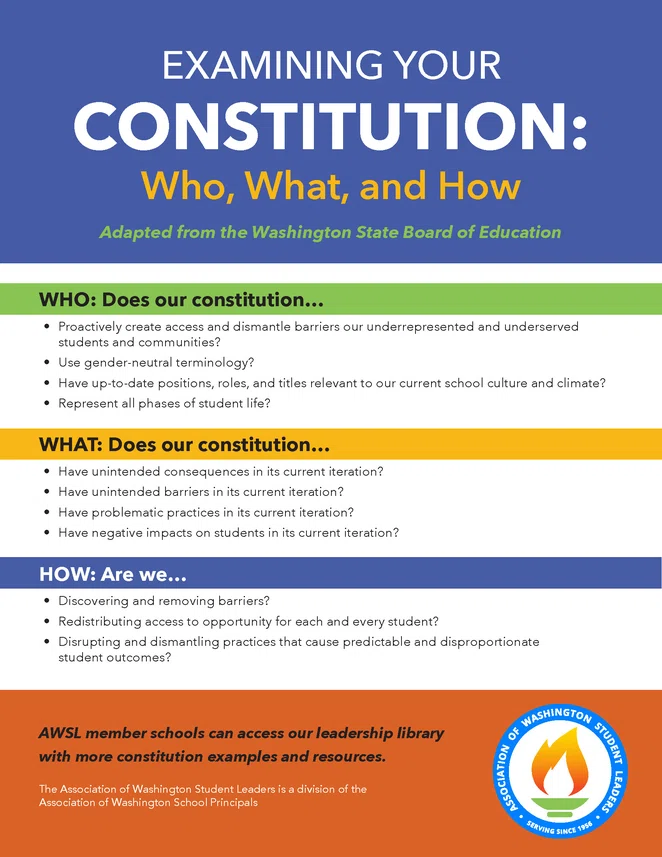
Association of Washington School Principals
Volume 3 – 2020-21
Student Leadership

Discover. Design. Disrupt.
Time to Dig into Your School’s Constitution
James Layman
Director of Student Programs, Association of Washington Student Leaders
Evaluation Criteria: Creating a Culture, Planning with Data, Closing the Gap
Within AWSL and AWSP, we have invested intentional time to examine our practices, procedures, language, mission, and vision. We have looked inward and asked ourselves, “Does the language we are using fit our current initiatives, and more importantly does it fit with where we hope to be in the future?” “Future-proof” has been a term that has danced around our internal lexicon as we continually work to be relevant and vibrant for our members and member schools. We have also adopted the lens of J.E.D.I. (justice, equity, diversity, and inclusion) into our work. It has led to rich and purposeful conversations where we have been able to reflect and assess who we are and whom we want to be.
Through this time of AWSL and AWSP focusing on the “doing” side of the paradigm and reflecting on how our vision and mission coincides with our culture, systems, and learning, we have become better. Our messaging and branding have been more strategic and concise. This opportunity exists for you as well, and it begins with examining your school constitution.
When is the last time you read through your school’s constitution? Does it reflect your school’s current operating procedures? Does it reflect your school’s current culture and climate? When is the last time students read through your constitution? Does your constitution carry unintended consequences for students? Now is the time to discover, design, and disrupt the status quo and ensure that your constitution supports each student’s betterment.
Where do you start? Find a diverse group of students that are reflective of your school demographics. Having a diversity of thought and perspective will only enrich the depth and inevitable outcome of the process. Yes, having ASB/Leadership/Student Council students a part of the process is important, but do not stop there. The genesis of educational inequities and disproportionate student outcomes often begins when we seek one pocket of students to be involved rather than intentionally opening doors for more to participate.

When is the last time you read through your school’s constitution? Does it reflect your school’s current operating procedures? Does it reflect your school's current culture and climate? When is the last time students read through your constitution? Does your constitution carry unintended consequences for students?
Discover. The first step is to discover antiquated practices, procedures, and policies. Does your constitution reflect the current positions, roles, and titles of your student government system? Another opportunity within your constitution is to look for gender-specific titles. Using they/them, student or position-specific titles can support your constitution in supporting all gender identities within your school community.
In the discovery phase, searching for unintended barriers that limit access and opportunity for underrepresented and underserved students is crucial. “Every system is perfectly designed to get the results it gets” - Dr. Paul Batalden. Dr. Paul Batalden is a Senior Fellow, Institute for Healthcare Improvement (IHI), is Professor Emeritus of Pediatrics, Community and Family Medicine and The Dartmouth Institute for Health Policy and Clinical Practice at Dartmouth Medical School.The quote rings true on many levels, and that includes your school constitutions. Many constitutions are riddled with systemic practices and language that do not allow for inclusion, belonging, and equity to be actualized.

Design. The opportunity and privilege to design your constitution in your school community’s best interest is a wonderful exercise in understanding language, perspective, and policy. Considering the unintended consequences, barriers, problematic practices, and negative impacts within your constitution come to light in this stage. In this stage, it is imperative to have multiple perspectives and diverse student voices incorporated and considered.
This stage is an opportunity to dig into the Washington State Social-Emotional Learning Standards’ social engagement standard with your students. Having students consider others and show a desire to contribute to their school and community’s well-being is what the design phase is all about.
Disrupt. Disrupting the status quo and norms can feel like an audacious thing to take on. Suppose we reframe our perspective and see this as an opportunity to inch our schools closer to Maslow’s Hierarchy of Needs’ self-actualization phase. In that case, a minor disruption may be a good thing.
Consider the school leader paradigm during this phase. Your constitution is a mixture of the culture, systems, and learning of your school. Is your current culture, or the culture you aspire to achieve, reflected in your constitution? Perhaps your constitution anchors your school's ability to become the best version of itself.
The systems and practices your school uses to govern your student body may be adversarial to growth and transformation, and may in their current form, uphold systems that do not support each and every student.
The importance of your constitution cannot be understated. Moreover, ensuring that your constitution is up to date and serves your building holistically is vital to ensuring that we can do what’s best for kids every day. Have fun with the process of discovering, designing, and disrupting. As Brené Brown has taught us, “The magic is in the mess.” ◼
Find us on
Association of Washington School Principals
Washington Principal | Volume 3 – 2020-21

